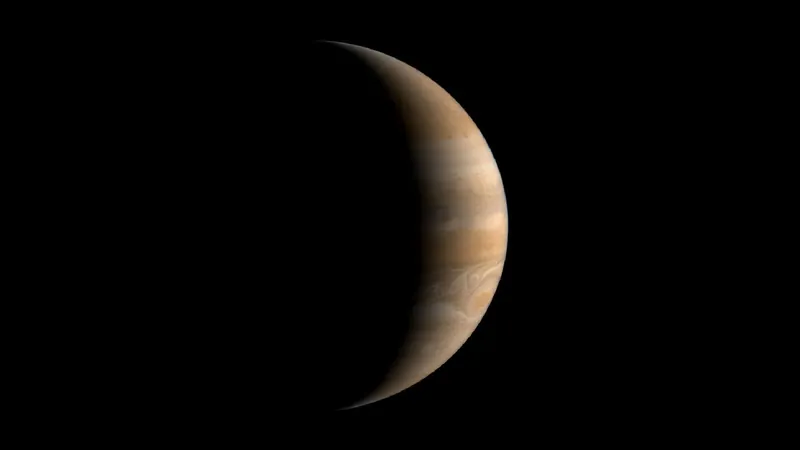
Did an Interstellar Intruder Rewire the Orbits of Our Outer Planets? A Shocking New Study Reveals the Unexpected!
2025-01-19
Author: Sarah
Interstellar Visitor's Impact on Our Outer Planets
A groundbreaking study suggests that a planet-sized visitor from beyond our solar system may have dramatically altered the orbits of our four outer planets—Jupiter, Saturn, Uranus, and Neptune—potentially reshaping our cosmic neighborhood millions of years ago.
The Mystery of Planetary Orbits
For years, astronomers have wrestled with the mystery of how the planets of our solar system came to be. Most prevailing theories propose that the planets formed orbits that are circular and aligned in a flat plane around the sun. If you were to observe them from the side, you would see a neat line. However, reality tells a different story: none of the eight planets, including our home Earth, have perfectly circular orbits, nor do they sit neatly on the same plane.
The Discrepancies in Planetary Trajectories
When compared to Mercury, which boasts the most elliptical and tilted orbit in our solar system, the trajectories of the outer giant planets are slightly askew from the expected norms. Deciphering why these discrepancies exist has been a long-standing challenge in theoretical astrophysics. According to Renu Malhotra, a planetary scientist from the University of Arizona and a co-author of the new study, previous hypotheses fell short in explaining these orbital quirks.
A Bold Hypothesis
To crack this cosmic conundrum, Malhotra and her team considered a more adventurous possibility: what if a massive visitor from another star system ventured into our solar system approximately 4 billion years ago and altered the orbits of our outer planets?
Simulations and Discoveries
Utilizing sophisticated computer simulations, the team conducted an impressive 50,000 trial runs over the span of 20 million years, varying parameters such as the mass and speed of the interstellar visitor and how closely it approached the sun. They broadened their investigation to include objects as small as Jupiter itself and explored scenarios where this intruder passed startlingly close to the sun—within just 20 astronomical units (AU), where one AU is roughly 93 million miles.
Results of the Simulations
While the majority of these simulations did not replicate our current solar system's layout, about 1% produced conditions strikingly similar to what we observe today. In these near-perfect scenarios, the passing planet-like intruders zoomed past the outer planets and even approached Mercury, with masses ranging from two to 50 times that of Jupiter—a size spectrum that includes "failed stars" known as brown dwarfs.
Further Investigations into Terrestrial Planets
The research team didn't stop there; they ran an additional 10,000 simulations involving the terrestrial planets—Earth, Mars, Venus, and Mercury—finding that the flybys could recreate the solar system's present appearance as well. The simulation that yielded the most accurate results involved a hypothetical object eight times the mass of Jupiter that came perilously close—just 1.69 AU from the sun, slightly beyond where Mars currently orbits.
Implications of the Findings
Astoundingly, just one such flyby of a substellar object seems to have been enough to tweak the giant planets' orbits into their present configurations. Given that observations suggest there are many substellar bodies scattered throughout the universe, it's plausible that encounters like this weren't just rare accidents but might be relatively common occurrences in the cosmic scheme.
Conclusion: A Hidden Path to Understanding Exoplanets
As we continue to explore the vastness beyond our planet, this new insight not only deepens our understanding of our solar system's formation but may also hold clues about other far-flung planetary systems influenced by similar interstellar wanderers! What could this mean for the search for life beyond Earth? The possibilities are endless!


 Brasil (PT)
Brasil (PT)
 Canada (EN)
Canada (EN)
 Chile (ES)
Chile (ES)
 Česko (CS)
Česko (CS)
 대한민국 (KO)
대한민국 (KO)
 España (ES)
España (ES)
 France (FR)
France (FR)
 Hong Kong (EN)
Hong Kong (EN)
 Italia (IT)
Italia (IT)
 日本 (JA)
日本 (JA)
 Magyarország (HU)
Magyarország (HU)
 Norge (NO)
Norge (NO)
 Polska (PL)
Polska (PL)
 Schweiz (DE)
Schweiz (DE)
 Singapore (EN)
Singapore (EN)
 Sverige (SV)
Sverige (SV)
 Suomi (FI)
Suomi (FI)
 Türkiye (TR)
Türkiye (TR)
 الإمارات العربية المتحدة (AR)
الإمارات العربية المتحدة (AR)